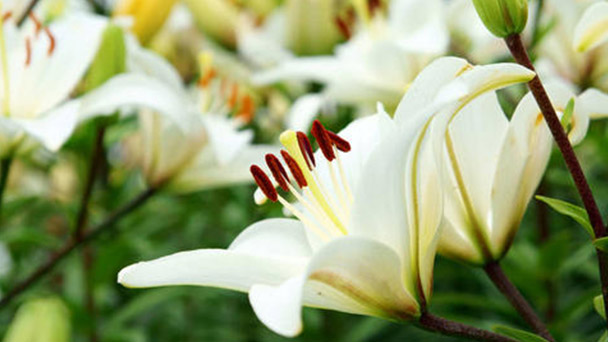How to grow and care for lily
Written by Maggie
Jan 11 2021

I believe that very few people can refuse the fragrance of lily and appearance leve. Placing a basin in the sitting room, the full room is fragrant, gladdening the heart and refreshing the heart and spleen. Lilies are tough and easy to grow and nurture, so instead of spending money on them, take a step forward and enjoy the process of growing and caring for lily.

Lily growing steps
1. Find the right spot.
The ideal location is in your garden, with good drainage and plenty of sun.
To find a location with good drainage, you can look at where in the garden rainwater dries out fastest. If there isn't an obvious location, grow the lilies on a slope and let gravity do the draining.
Find a spot where you'll get at least half the sun. If the lilies stay in the shade for too long, they tend to grow toward the sun, creating a marked slant.Ideally, you'll get a full day of sunshine.
If grown in a less than ideal location, lily leaves may become infected with the fungus botrytis. While bovine spores are beneficial for certain types of wine grapes, they reduce the area on the leaves used to produce sugar that can be used to produce fresh, healthy lily bulbs.
2. When you have the lily bulbs, plant them.
When preparing lily bulbs, you also need a thin covering called a membrane, which stops the bulbs from dying.
The faster you grow lily bulbs after you get them, the better they will grow. If you can't grow them right away, keep them in a cold, dark place (like a refrigerator -- as long as it's above zero). The idea is to keep them from sprout, and if they do, you need to plant them.
Grow them in the fall or early winter so they bloom in the spring. You can also plant them in the spring and they will flower later in the year. They "usually" bloom the following spring.
3. Dig a hole.
Lilies like the sun, but they prefer to stay cool in the summer. Dig a hole about 10-15cm deep, the deeper the better -- it will not only protect the lily through the possible summer heat, but also provide good support for the stems.
You can also plant them on a platform: plant them at ground level and place 10 to 15 centimeters of soil on top of them. This will also facilitate drainage.
Arrange them appropriately. If you are planting multiple lilies, give each flower a radius of about 6 inches so that each flower has its place in the sun.
Loose the soil at the bottom of the pit, sprinkle a small amount of bone meal on the bottom, then put the lily bulbs in, and fill with the soil.
Water immediately. This allows moist soil to reach the roots and encourages lily growth.
4. Add mulch.
If you expect colder weather, add a layer of mulch to protect the plant's shoots.
The musk lily is the most vulnerable species to frost damage.
Make sure the mulch is insect-proof! Insects may damage the young lily shoots.

Lily care
1. Fertilizing care
When they start sticking out, add a balanced fertilizer. Lilies are quite tough and do not need a lot of fertilizer. In fact, too much nitrogen can cause flower stems to be weak, and hot and humid weather can also cause bulbs to rot.
For best results, choose a fertilizer that helps the potato grow.
Apply the fertilizer when the lilies start to sprout, and again about a month later.
2. Watering care
Lilies usually don't need a lot of water, so water them only when needed.
Asian lilies, musk lilies, and Oriental hybrid lilies can thrive in hot and dry climates provided they are provided with enough water until flowering time.
Oriental varieties of lilies need watering in the summer, and they don't flower until August.
Adding mulch in the summer helps keep lily bulbs cool, thus reducing the need for extra water.
3. Pay attention to anti-freezing.
In winter, cover the bed with straw or evergreen branches to keep the lily bulbs from freezing.
4. Pruning care
During the flowering season, build dead flowers and ensure that at least two-thirds of the stems are intact, ensuring that the lilies will thrive for years to come.
5. Disease prevention
If your lilies have brown spots on their leaves, they may be infected with botrytis. Botyspora is a fungus that appears in cold or wet weather. Spray the leaves with a rose fungicide.You can find rose fungicides at a nursery or hardware store.

Latest Updated
- Benefits of Bugleweed - 7 Science-backed Health Benefits
- Bugleweed Dangers & Side Effects - Is It Poisonous?
- How to Plant Evergreen Trees - What You Should Know
- When to Plant Evergreens - Grow Guide for Evergreen Trees
- 12 Wonderful Evergreen Shrubs for Your Garden
- 12 Popular Evergreen Plants with Pictures for Beginners
- When And How To Prune A Lilac Bush Like a Pro
- How to Grow & Care for Lilac Vine (Hardenbergia Violacea)
- Japanese Lilac Tree (Syringa Reticulata) Care & Propagation Guide
- Shumard Oak Pros and Cons - What to Know
Popular Articles
- Winter maintenance of Antirrhinum Majus
- How to Grow Terminalia Mantaly Tree
- How to Grow and Care for Crossostephium Chinense
- How to grow Antirrhinum Majus in spring
- Peristeria Elata (Dove Orchid) Profile: Info & Care Guide
- Underwatered Snake Plant (Sansevieria Trifasciata) - Signs And How To Fix
- How to Care for Brazilian Jasmine Plant (Mandevilla Sanderi)
- How to Grow & Care for Graptopetalum Purple Delight in Summer
- Rosa Chinensis (China Rose): Plant Growing & Care Tips
- How to Care for Baby Sun Rose (Aptenia Cordifolia)